Euryplatea nanaknihali
| Euryplatea nanaknihali | |
|---|---|
 | |
| Scientific classification | |
| Kingdom: | Animalia |
| Phylum: | Arthropoda |
| Class: | Insecta |
| Order: | Diptera |
| Family: | Phoridae |
| Genus: | Euryplatea |
| Species: | E. nanaknihali |
| Binomial name | |
| Euryplatea nanaknihali Brown, 2012 | |
At just 0.4 millimetres (0.016 in) in size, Euryplatea nanaknihali is the world's smallest fly (Diptera).[1]
Due to its small size, the viscosity of air is problematic for the insect, and even the smallest air currents are a large problem. Scientists expressed amazement that such a tiny animal could still have all the organs of a normal insect.[2]

They are believed to lay their eggs in the body of small Crematogaster ants. The larva devours the body of the ant, within which they mature before emerging as adults.[2][3]

The species was found in a number of national parks in Thailand. Brown named the fly after Nanak Nihal Weiss, a thirteen-year-old interested in insects who frequents the Natural History Museum of Los Angeles County with his father.[4]
References
- ↑ Brown, B.V. 2012: Small size no protection for acrobat ants: world's smallest fly is a parasitic phorid (Diptera: Phoridae). Annals of the Entomological Society of America, 105(4): 550-554. doi:10.1603/AN12011
- 1 2 Chelsea Whyte (July 2, 2012). "World's Smallest Fly Decapitates Ants and Lives in Their Severed Heads". International Science Times. Archived from the original on January 4, 2014. Retrieved July 20, 2012.
- ↑ "World's smallest fly discovered in Thailand". ScienceBlogs. July 3, 2012. Archived from the original on January 4, 2014. Retrieved January 4, 2014.
- ↑ Black, Debra (July 9, 2012). "World's tiniest fly discovered by former Torontonian". Toronto Star. Archived from the original on January 4, 2014. Retrieved January 4, 2014.
| Wikispecies has information related to: Euryplatea nanaknihali |